Black Breath (1U207)
Back to Fellowship of the Ring Index |
Black Steed (1R208) |
Black Breath (1U207) is a Ringwraith Condition from the Fellowship of the Ring set.
| ||||||||||||||||||||||||||||||||||||||||
| ||||||||||||||||||||||||||||||||||||||||
| ||||||||||||||||||||||||||||||||||||||||
| ||||||||||||||||||||||||||||||||||||||||
Strategy[edit]
Black Breath is a powerful, flexible condition that can be used in conjunction with nearly any other Nazgul strategy to severely limit the Free People's options in skirmishes and with abilities that require exertions. It is particularly evil when applied at sites 3 or 6, as your opponent will not have a chance to remove it until after the sanctuary healing has already taken place. Since it is a Skirmish ability, your Nazgul need not win the skirmish to get this blight on your opponent and begin the long road to a painful death.
!Black Breath synergies with a few other Nazgul cards in some very nasty ways. First and foremost, when combined with Blade Tip (1U209)
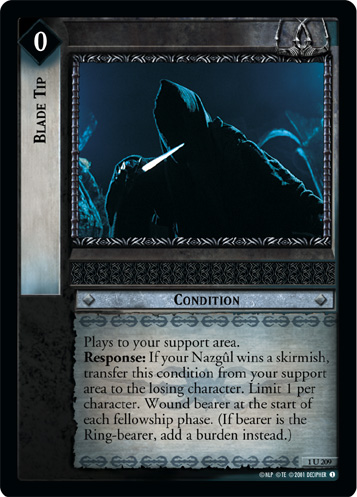 on the same companion, your opponent will be forced to be adding wounds each turn with no way to remove them, effectively making that companion a time bomb. Even better, if they have only one condition removal ability available, they will usually select Blade Tip, leaving Black Breath to slowly suffocate that companion. In addition, Black Breath has no limit per companion, so you can place two or three on the same person should you so desire. This normally is a bad idea, but if for instance you can see your opponent's Athelas (1U94)
on the same companion, your opponent will be forced to be adding wounds each turn with no way to remove them, effectively making that companion a time bomb. Even better, if they have only one condition removal ability available, they will usually select Blade Tip, leaving Black Breath to slowly suffocate that companion. In addition, Black Breath has no limit per companion, so you can place two or three on the same person should you so desire. This normally is a bad idea, but if for instance you can see your opponent's Athelas (1U94)
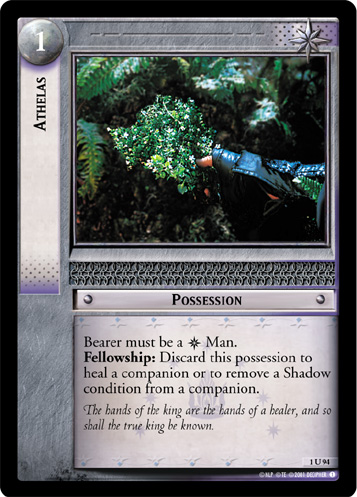 on the table, you can ensure that particular companion walks away with at least one negative condition on him at the end of the turn. This may cause your opponent to decide to sacrifice that particular character, too, which you might orchestrate to be exactly what you want.
on the table, you can ensure that particular companion walks away with at least one negative condition on him at the end of the turn. This may cause your opponent to decide to sacrifice that particular character, too, which you might orchestrate to be exactly what you want.
Úlairë Lemenya, Lieutenant of Morgul (1U232)
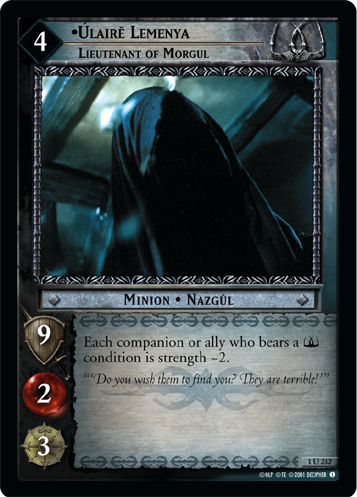 , really shines with Black Breath in your support area. With his ability, you can use the Black Breath as a targeted, semi-permanent -2 strength, which can be detrimental if backed up with a The Witch-king, Lord of Angmar (1R237)
, really shines with Black Breath in your support area. With his ability, you can use the Black Breath as a targeted, semi-permanent -2 strength, which can be detrimental if backed up with a The Witch-king, Lord of Angmar (1R237)
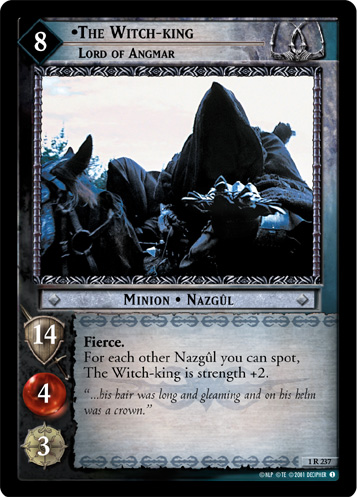 or Úlairë Attëa, Keeper of Dol Guldur (1R229)
or Úlairë Attëa, Keeper of Dol Guldur (1R229)
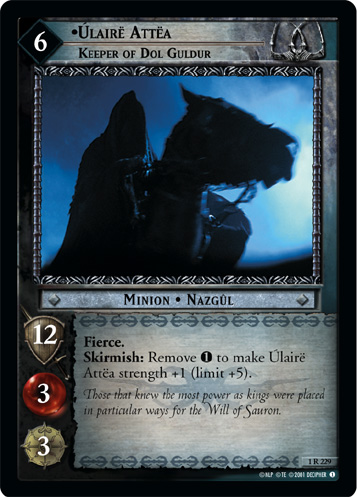 on the same turn.
on the same turn.
Strengths and Weaknesses[edit]
Synergizes With...[edit]
- Combine with Blade Tip (1U209)
 to force a companion's early (or prolonged) death
to force a companion's early (or prolonged) death - Use with Úlairë Lemenya, Lieutenant of Morgul (1U232)
 to selectively weaken companions
to selectively weaken companions - Use with Úlairë Nelya, Fell Rider (15R186)
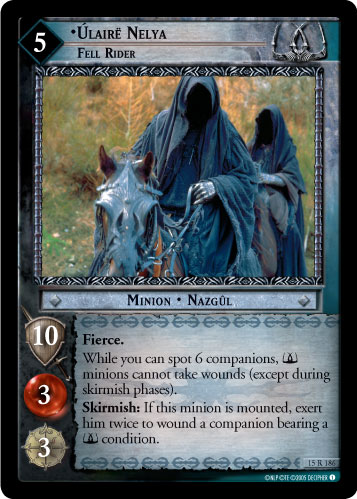 to target wound
to target wound
Weak Versus...[edit]
- Athelas (1U94)

- Secret Sentinels (2R20)
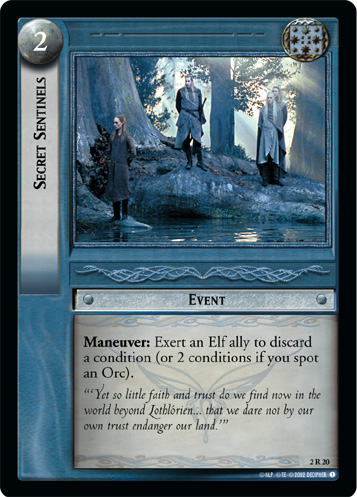 (your opponent will often wait until the turn you have Morgul Skulker (1U258)
(your opponent will often wait until the turn you have Morgul Skulker (1U258)
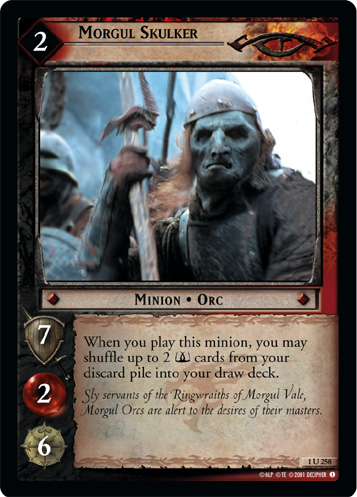 on the table if you play the card ahead of time, unless its urgent)
on the table if you play the card ahead of time, unless its urgent) - Condition removal nukes (such as Grown Suddenly Tall (4R92)
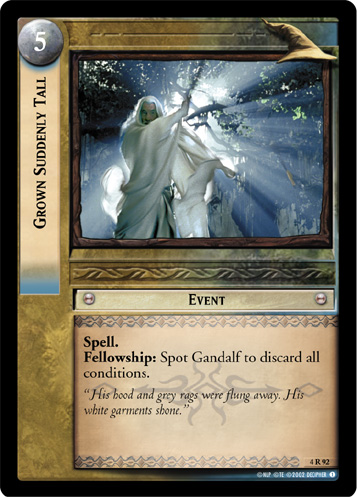 or Deep in Thought (3C30)
or Deep in Thought (3C30)
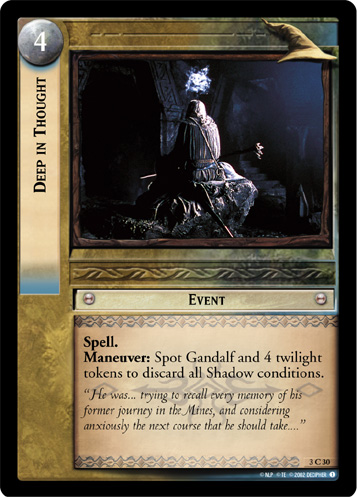 )
)
Decipher's Take[edit]
The Ringwraith culture offers some of the most versatile minions in the game. For a reasonable twilight cost you get minions with 9-12 strength, the Fierce keyword, and site numbers of 2 or 3. The end result is that by playing Nazgul you can hit hard and fast. Nevertheless, at early sites the twilight pool is often small and only enough to play one Nazgul. Clearly, a minion side with all Nazgul and unique weapons will be somewhat risky. As a result, Nazgul players must attempt to minimize their chances of drawing an unplayable hand early in the game and this can be accomplished by incorporating a variety of low twilight-cost support cards. Black Breath is one such card that has seen substantial use in many top-ranking tournament decks.
The power of Black Breath is twofold. First is in its ease of play - particularly important to the usually slow-cylcing Nazgul decks. It costs only 1 twilight, which makes it easily playable in the early turns of a game, even in conjunction with the playing of a Nazgul; very often 1 or 2 twilight will be left over from playing a Nazgul at sites 1-3. Unlike events, Black Breath is a condition, so you can play it as soon as you draw it, and it doesn't require spotting a minion, or anything else, to play, facilitating cycling of your hand.
The condition's only requirement for transfer to an opponent is that one of your Nazgul skirmishes a companion - it doesn't even have to win. Although your Nazgul will most certainly be winning skirmishes in your game, they might have some difficulty early on when twilight is scarce. Therefore, this is the perfect time to transfer Black Breath to a companion (or ally!) - when the fellowship is at its weakest.
The second is its ability to aid both a killing strategy, where the intent is to beat the opponent by killing off their companions one by one, and a slowing strategy, where the intent is to slow your opponent down, letting you get to site 9 first. Killing is aided by reducing the effectiveness of your opponent's main skirmishing characters - being able to get a Black Breath on a companion early in the game, particular before the site 3 sanctuary, ensures that your opponent must be extra careful with that companion for the rest of the game, often crippling it, and your opponent's fellowship strategy along with it (imagine a Trust Me deck without the ability to remove wounds from Gandalf!).
The inability to remove wounds can slow your opponent dramatically as well, by removing their flexibility. Attaching this card can be particularly troublesome for the fellowship early in the game. They will be less confident about double moving to site 3 with a small, wounded fellowship; they risk losing companions in the mid-game if they can't cycle their fellowship cards well. In the long term, Black Breath is equally troublesome because it reduces the vitality available to absorb wounds from the skirmish-winning Nazgul. Multiple copies in play can even put enough pressure on your opponent that they will have trouble double-moving late in the game, when Nazgul are often less effective.
>by Hayden-William Courtland









